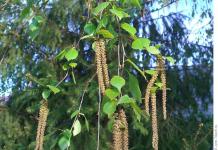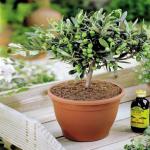The olive tree, of the olive family, grows in countries with a warm subtropical climate; in Russia it is cultivated in the southern regions: in Crimea and the Krasnodar Territory. The middle zone of our country is not suitable for growing olive crops, but you can grow an olive tree in a greenhouse or at home with a minimum of effort.
Table varieties of olives, with proper care, will delight you with fruits for a long time, because olive trees are among the longest-livers of the plant world. An example is the Gardens of Gethsemane, with olive trees over one and a half thousand years old.
Greece is called the birthplace of olive culture; there is a legend that the Greek goddess Athena sent an olive branch as a gift to the fertile land, which gave rise to the first olive gardens.
Types and varieties of olive trees
The olive tree has more than 30 types of crops. The most common type remains the European olive, as well as the golden-leaved and cape olive.
Olive tree varieties can be divided into several groups:
Oilseed is a varietal group of olives grown for the production of olive oil.
Combined (universal olive variety) - intended for both oil production and preservation.
Table variety group - intended for preservation and consumption.
The names of olive varieties are often similar to where the crop is grown. Wild varieties of olives are unknown; the explanation can be that people have long since, in order to increase yield, grafted branches of cultivated olives onto wild varieties, thereby completely destroying the primitive species of olive trees. Today, the European high-yielding variety of olives is grown on an industrial scale.
Large producers of olives include Spain, Greece, Italy, Tunisia, Syria, and Morocco. All cultivated varieties differ in their characteristic characteristics (olive composition, size, color), group of destination, the quality of the final product directly depends on the type of olive raw material.
Table olive varieties include: Spanish, Ascolana, Cerignola, Zinzala, Lucca, Sabina. And oilseed varieties include: Frantoño, Taggiasca, Caione, Biancolilla.
To grow an olive tree at home, choose European table varieties. The most suitable are: Della Madonna, Urtinsky, Nikitinsky, Krymsky, Razzo. To the question: “How long does an olive tree live?”, we can safely say that it is more than a hundred years.
Through the painstaking work of breeders, potted varieties of olive trees have been obtained, making it possible to grow an indoor olive tree in a pot. Such trees differ from their relatives only in size. These are evergreen, low-growing trees with a lush, dark green crown. The harvest of olives, of course, will not please you, since the variety has a decorative function, but you can still collect 10-15 homemade olives from a tree.
Olive tree at home. Growing with seeds, seedlings and cuttings
 Growing an olive tree indoors is quite a painstaking job. It's all about the temperature regime, if it is not observed, the tree will not bear fruit. In order for buds to appear, the indoor tree, like its soil counterparts, must fall into winter sleep, so the olive must be exposed to low temperatures, but avoid overcooling the crop. The optimal temperature for sleeping will be from +1 to +5 degrees.
Growing an olive tree indoors is quite a painstaking job. It's all about the temperature regime, if it is not observed, the tree will not bear fruit. In order for buds to appear, the indoor tree, like its soil counterparts, must fall into winter sleep, so the olive must be exposed to low temperatures, but avoid overcooling the crop. The optimal temperature for sleeping will be from +1 to +5 degrees.
The flowering of the olive tree is accompanied by the appearance of large white inflorescences; the first flowers appear in April and May. Ripening of indoor fruits after flowering occurs after four months.
A good yield for an olive tree is considered to be about 30 kg, but a houseplant is considered fruitful if it produces about 600 grams. olives
The indoor olive tree remains evergreen throughout its entire life, however, like its large relatives, it can shed its leaves; this is considered the norm and does not require resuscitative actions.
Growing an olive tree from seeds is not an easy process and requires patience and attention. First, you need to purchase olive seeds (pits), canned products are not suitable, olives for planting can be fresh or dried.
So, having obtained and cleaned the olives, you need to soak the resulting pits in a weak alkali solution for a day, then rinse them with water and dry them with a paper towel. Before planting, you should cut down the olive seed shell to facilitate germination. It is better to plant in a pot, as it is easier to control seed germination, humidity and temperature.
The sawn seeds are placed in a pot with soil to a depth of 3 cm; do not allow the seed to dry out or over-moisten it. The first shoots will appear within six months.
Olive trees do not tolerate low temperatures, so propagation by seeds is carried out in a warm room or in the summer.
To speed up the process of growing an olive tree from a seed, you should germinate the seeds before planting in the ground, to do this, place them in a shallow container with compost, place them on a sunny windowsill and moisten them daily.
When the seeds germinate, you can begin planting in the soil. It is necessary to mix chernozem and sand in equal parts, add peat, dry crushed lime and plant seeds in the resulting mixture. Before planting, do not forget about the presence of drainage (olive does not tolerate stagnant water) and hardening of the young plant using the method of alternating temperatures.
When the olive seedling gets stronger and grows, it can be planted in the ground, along with the contents of the pot, so as not to damage the root system. The olive tree is planted in the spring in well-warmed and moist soil, in an area that is windless and rich in sunlight. Fruiting should be expected three to four years after planting.
 Caring for a young oilseed plant consists of cutting off the lower shoots so that the tree grows upward and does not turn into a bush, daily watering and fertilizing with fertilizers.
Caring for a young oilseed plant consists of cutting off the lower shoots so that the tree grows upward and does not turn into a bush, daily watering and fertilizing with fertilizers.
When an olive tree is propagated by cuttings, the tree inherits all the “maternal” qualities; this planting method simplifies further cultivation and speeds up the process of fruiting of the young plant.
Cuttings should be carried out from older shoots; the cut sites are treated with succinic acid or another rooting agent before planting. Planting material is planted in a moist turf-sand mixture to a depth of 15 cm.
Constant watering, warm soil and good lighting can help the cuttings take root. Plants should be watered daily, preferably with settled water. Rooting of the plant will occur no earlier than four months later. If the olive cutting does not take root for a long time, but retains its fresh appearance, then some more time is needed, but if the cutting has dried out and turned brown, then death has occurred. Once the cuttings have taken root, the olive can be transplanted into the ground.
Planting to a permanent growth site should be done at the end of August. The seedling is carefully removed from the pre-moistened substrate and placed in a new prepared place. The cuttings must be planted carefully, without damaging the roots or overloading them with soil, until the plant takes root in its new location.
Many novice gardeners ask the question: “How to care for an olive tree”? The olive tree is not capricious, but the “southerner” still requires attention. Watering is done daily, but without stagnating moisture in the soil. When the olive tree begins to actively grow, feed it with mineral fertilizers and nitrogen. The seedling must have enough warmth and light, otherwise the olive tree will begin to shed its leaves and become dull.
In winter, an olive plant cannot be left in the open ground without proper protection. A young tree should be protected from the cold by wrapping the trunk with thermal insulation material, and stop watering and fertilizing.
Potted olive tree crops need to artificially create winter conditions, and in the process of healing the tree, by cutting dry branches, you can shape the foliage crown to your liking and learn the art of bonsai on your olive tree. Olive bonsai trees can also be purchased at a specialized supermarket; small-leaved varieties look especially impressive.
Olive trees in Russia, history of cultivation
 Greek colonists began cultivating olives in the Caucasus back in the 8th century. Disputes about when and by whom the olive was brought to the Caucasus continue to this day, however, there is an assumption that the first olive tree seedlings appeared in our latitudes from Asia Minor, which suggests the origin of the olive in the Caucasus, earlier than in Greece .
Greek colonists began cultivating olives in the Caucasus back in the 8th century. Disputes about when and by whom the olive was brought to the Caucasus continue to this day, however, there is an assumption that the first olive tree seedlings appeared in our latitudes from Asia Minor, which suggests the origin of the olive in the Caucasus, earlier than in Greece .
The desolation of the ancient colonies of the Greeks led to the fact that olive gardens ceased to exist until the 15th century, and only with the arrival of the colonizers of Genoa, a new rise in the cultivation of the olive tree and the establishment of production of olive products began. Subsequently, the olive was displaced from the southern latitudes by viticulture. Today olive is found throughout the Black Sea coast of the Krasnodar Territory.
Olive trees in Russia are also grown in Crimea; they are found on the peninsula, adding zest to the local southern flavor. For the production of oil on an industrial scale, olives are not grown in our country due to difficult climatic conditions.
Benefits of olive tree fruit
Olives or olives are the fruits of the olive tree; in appearance they are similar to small plums. Changing color during ripening, from green to dark purple, olives become a storehouse of vitamins and microelements. Olives are rich in unsaturated fatty acids and iodine. Olive oil obtained from olives during the production process is rich in pectin, iron and oleic acid.
Including olive oil in the diet will help get rid of cardiovascular diseases and atherosclerosis, diseases of the gastrointestinal tract, cholelithiasis, thyroid diseases, help strengthen the immune system and cope with constipation. Olive oil perfectly moisturizes the skin and has a regenerating ability in combination with rosehip and sea buckthorn oils.
In cosmetology, olive oil is used to prepare masks and carry out relaxing procedures; olive extracts are added to soap and shower products. Wrapping hands with olive oil tones the skin, moisturizes, saturates and nourishes, and makes nails healthy.
Hair masks with olive oil prevent hair loss, eliminate dandruff, brittleness and dullness.
 Olive tree leaves contain the substance oleuropein, which has antiseptic and antimicrobial effects; they are in demand in the form of powder and infusions. There is an opinion that olive oil, namely the oleuropein content in it, helps in the fight against skin cancer.
Olive tree leaves contain the substance oleuropein, which has antiseptic and antimicrobial effects; they are in demand in the form of powder and infusions. There is an opinion that olive oil, namely the oleuropein content in it, helps in the fight against skin cancer.
Olive fruit is used to produce table olive oil, which is used to season various dishes. Olives in their raw form are unsuitable for consumption; due to their bitterness, in order to get rid of the bitter taste, olives are soaked in a special solution or canned.
Oil bearing varieties of olives, due to their varietal, are processed to obtain oil. Using cold pressing, the first batch of oil is obtained, which is considered the most useful. Next, by thermal exposure, second-press oil is obtained from the pomace, which is yellowish and less aromatic than first-grade olive oil. From the remaining raw materials after the first and second pressing, third-grade oil is squeezed out; it is not consumed as food, but used for technical purposes.
The composition of olives of different varieties differs, and depends not only on the type of olive tree, but also on the growing conditions and climate. All table olives are canned or dry salted. They serve as an excellent snack or addition to salads and various vegetable dishes. Dry salting of olives involves salting olives in wooden containers; the salt neutralizes oleuropein and relieves the olives of bitterness. Afterwards, the olives are soaked in olive oil, stuffed or immediately sent for storage.
The benefits of the fruits of the olive tree are undeniable; consuming olives in reasonable quantities, not exceeding 5-6 pieces per day, can strengthen the immune system and improve the functioning of the gastrointestinal tract.
Olives and olives - what's the difference? Most people are accustomed to thinking of green fruits as olives, and black ones as olives. Some are sure that the berries grow on different trees, while others believe that the fruits have different degrees of ripeness. We suggest you understand the secrets of growth, taste, harm and benefits of fruits.
Olive is a tree that produces both olives and olives. Moreover, only in Russia the fruits are called olives. Throughout the world, their common name is olives.
The tree grows only up to a meter in height, but it can grow significantly in breadth. If you do not properly care for an olive tree, it very quickly turns into a bush and dies due to insufficient light at the base.
Olive is a very resilient plant that survives in dry conditions and tolerates frosts down to 10 degrees. A distinctive property of wood is its ability to renew itself and reproduce.
When harvested, green fruits are removed by hand and placed in special baskets. To collect ripe berries, which fall off on their own, they use small nets, hanging them under each tree.
The berries on the tree grow poisonous green, then their color changes to grass green, then purple and turns into bright black fruits, which are saturated with a lot of oil.
Tasty and nutritious fruits have a fibrous structure and are well absorbed by the body.

- phosphorus;
- calcium;
- B vitamins;
- copper;
- oleic acid;
- magnesium;
- folic acid;
- selenium;
- vitamin E;
- potassium;
- vitamin K;
- zinc;
- choline;
- iron;
- sodium.
The difference between olives and olives in the chemical composition is minimal and is explained by the fact that the berries have a different ripening process.
The calorie content of olives is 145 kcal per 100 grams, while that of olives is 168 kcal.
Green olives contain 1 g of protein, 0.6 g of carbohydrates, and 15.3 g of fat.
Black olives contain more oil, so they include 16 g of fat per 100 g, 1.4 g of protein, and 4.7 g of carbohydrates.
You don't have to worry about swallowing olive pits. They have the ability to be completely digested within the body.
The difference between black olives and olives lies not only in the chemical composition, but also in taste.
Only processed fruits are on sale, since fresh berries are inedible due to their strong bitterness. The fruits are salted, pickled and stuffed with various fillings. In our country, berries are found in canned form in stores, but in Greece you can enjoy the fruits of dry pickling.

There is a difference in taste, but due to the large supply of low-quality products, few people can tell the difference between these two berries. The main difference is the degree of maturity. Black fruits are ripe and contain more olive oil. This moment greatly affects the taste and divides berry lovers into two camps, those who love ripe fruits and green ones.
Olives are juicier and softer. Easily fall apart. They have a rich, specific oily taste. Olives are firmer, sharper and characterized by a pungent taste that leaves a tart taste in the mouth.
What is tastier than black olives or black olives?
People's tastes and preferences are different, so it is difficult to answer the question of what tastes better. Due to the fact that green fruits are more elastic, they can be stuffed, thereby giving the fruits new taste sensations. Thanks to preservation, the berries lose their natural bitterness and are valued for their variety of taste qualities when pickled.

Black fruits have earned recognition and love for their oiliness and softness.
Useful properties and contraindications

The berry is very beneficial for the body, regardless of color.
- With constant use, the likelihood of developing cancer is reduced.
- Berries have a positive effect on the cardiovascular system, help reduce bad cholesterol levels, and improve blood condition. They are good prevention of vascular and heart diseases.
- They have a beneficial effect on the gastrointestinal tract and liver. Cleanse the body of waste and toxins. With regular consumption of black fruits, the risk of gastric ulcers is significantly reduced. Helps improve intestinal microflora and metabolism. Helps in the fight against constipation.
- If you want to protect your body from stone formation, consume olives regularly.
- They strengthen bone tissue and joints, prevent diseases of the musculoskeletal system, and have healing effects for osteochondrosis, arthritis and gout.
- Have a beneficial effect on muscle tissue.
- Due to the high content of vitamin B, they have a beneficial effect on the skin and hair.
- If your eyesight is impaired, it is recommended to regularly consume berries, regardless of color.
- Helps slow down the aging process in the body.
But in addition to all the listed beneficial properties, the fruits have a contraindication.
Cannot be consumed in large quantities. The fruits are sold in canned form, which means they are salted, which is harmful to the body. When consuming, remember - everything is good in moderation.
Why do olives and olives differ in color?
Fruits that are picked from the tree when unripe are colored white or green. Such berries are sent to markets and stores only after preliminary processing - salted, stuffed or pickled.

Ripe berries are painted in a dark color, which nature itself gave them. They differ from green ones in their higher oil content, amazing flavor and softness, and, as a rule, more expensive cost.
If you purchased berries that are uniform and very dark in color, almost black, then they have been processed. Green berries are oxidized by oxygen. The procedure takes about a week, sometimes a little more, after which the fruits acquire a beautiful glossy black color with tints. Real olives are never evenly colored; there are always transitions. Therefore, read the composition. Honest manufacturers always indicate information on the can.
To identify real, ripe olives in a jar or processed ones, pay attention to the brine. If it is transparent, then the berries are natural.
Images
on Wikimedia Commons
| ITIS | |
| NCBI | |
| GRIN | t:25555 |
| IPNI | 610675-1 |
| TPL | kew-355112 |
European olive, Olive cultivar, or olive Tree(lat. Olea europaea) - an evergreen subtropical tree of the Olive genus ( Olea) family Olive ( Oleaceae). The plant has been cultivated since ancient times to produce olive oil; it is not found in the wild.
Other names - European olive, olive. Olive is also the name of the fruit of the olive tree; other names for the fruit - olive, olive .
Area
The cultivated form of European olive is grown in all Mediterranean countries, in Ukraine on the southern coast of Crimea, in Abkhazia, on the Black Sea coast of Russia (in the area of Gelendzhik, Tuapse and Sochi), in Georgia, Azerbaijan, Turkmenistan, Iraq, Iran, Pakistan and northern India. In 1560 it was brought to America, where it is cultivated mainly in Peru and Mexico. It was first cultivated in Greece, where it is grown in large quantities to this day.
Botanical description
Evergreen shrub 1-3 m or tree 4-5 (10-12) m tall. The trunk is covered with gray bark, gnarled, twisted, and usually hollow in old age. The branches are gnarled, long, and in some varieties drooping.
Leaves
The leaves are narrow-lanceolate, entire, gray-green, do not fall off in the winter and are renewed gradually over two to three years.
Flowers
Depending on the climate, olive trees bloom from late April to early July. The fragrant flowers are very small, from 2 to 4 centimeters long, whitish, with two stamens, located in the axils of the leaves in the form of paniculate racemes. There are from 10 to 40 flowers in one inflorescence.
If the tree experiences drought or lack of nutrients 6 weeks before flowering, the yield drops sharply as the number of flowers decreases. In this case, cross-pollination can help increase the yield.
Fruit
The fruit of the olive is a drupe, most often of an elongated oval shape, from 0.7 to 4 centimeters long and 1 to 2 centimeters in diameter, with a pointed or blunt nose, with a fleshy pericarp containing oil. The color of the fruit pulp varies depending on the type of tree. In different versions it can be either green, black, or dark purple, often with an intense waxy coating. The stone is very dense, with a grooved surface. Fruit ripening occurs 4-5 months after flowering. An olive tree is productive after 20 years. The tree has a rotation effect and bears fruit once every 2 years. The average olive fruit consists of:
90% of olives are used to make olive oil, which even without preservatives has a fairly long shelf life, which is of great importance for the Mediterranean. For commercial trade, olives are pickled with or without pits.
Abkhazia
On the territory of Abkhazia, the largest growth area is about 4,000 trees; it is located in New Athos, on the lands of the New Athos Monastery. Currently, in the Gagra region there are wild olive trees, living witnesses to the fact that in ancient times this crop was widespread in these places.
Azerbaijan
In the territory of present-day Azerbaijan, olives have been cultivated for a very long time. This is confirmed by the remains of this plant found during excavations in Absheron, Barda and other areas. Over time, the olive plantations of Azerbaijan were lost as a result of medieval wars, and there is no literary information about the development of this culture up to the 17th century inclusive.
Currently, one of the oldest trees has been preserved in the village. Nardaran (Baku), which is at least 180-200 years old. In Baku, in the Governor's Garden, there are about 100 trees aged 80-90 years, and in Ganja there are 6 trees of approximately the same age.
Georgia
Literary sources claim that olives have also been cultivated in Georgia since ancient times. At the end of the 18th century, significant plantings were created in the Tbilisi region, as well as in other places.
Italy
Italy's olive plantings are far superior to the classic olive-producing country of Greece. Olive is one of the main cultivated plants in Italy. Most of the country's olive plantings are co-located with grapes, citrus fruits, figs and almonds. According to 1958 data, a total of 226 thousand hectares were occupied by olive plantations in Italy. In 1965, 1,792 thousand tons of olive fruits were harvested in Italy.
Türkiye
Among olive-producing countries, Turkey ranks 4th in terms of the number of trees and 6th in terms of area occupied by them.
Ukraine
In Ukraine, olives are grown in Crimea, and they can grow not only on the southern coast, but also on the rest of the peninsula. According to inaccurate data, olive cultivation has been practiced in Crimea since 1785. And in our time you can find individual patriarch trees that are 400-500 years old. There are also group plantings in the form of small groves. The oldest olive tree in Ukraine grows in the Nikitsky Botanical Garden, which is estimated to be up to 2000 years old.
Croatia
In Croatia, olive plantations suffered greatly during World War II, where the German occupiers cut down and burned, according to incomplete data, more than a million trees.
Usage
Varieties
According to physico-chemical parameters and oil content, olives can be roughly divided into two groups: rich in oil content and less rich. Olives, rich in oil content, belong to the olive group. The second group includes varieties suitable for processing or canning varieties. The main indicators when evaluating canned varieties are the diameter of the fruit, its weight and the ratio of pulp and stone (the smaller the stone and the more pulp, the more valuable the fruit), the properties of the pulp and its chemical composition. Also, the grade of olives is determined depending on the place of growth, color, degree of maturity and size.
Food product
Since ancient times, people have eaten olive fruits and made olive oil from them.
Olives are rich in fat; The yield of oil to absolutely dry matter, depending on the pomological variety, ranges from 50 to 80%. The fruits are rich in proteins, pectins, sugars, vitamins: B, C, E, P-active catechins, contain potassium salts, phosphorus, iron and other elements. In addition, carbohydrates, catechins, phenolcarboxylic acids, pectin substances, and triterpene saponins were found in the fruits. The leaves contain organic acids, phytosterol, oleuropein glycoside, resins, flavonoids, lactone elenolide, bitter and tannins, essential oil, which includes esters, phenols, camphene, eugenol, cineol, citral and alcohols. The leaves contain glycosides, organic acids, bitterness, flavonoids and tannins.
Olive fruit oil is the main product for which this crop is mainly cultivated. But olive fruits are also widely used in the canning industry for making canned food from green fruits, and from black ones - dry-salted olives. Provencal olive oil is used in the food industry in the production of gourmet canned fish (sprats, sardines).
Canned olives, dry salted black olives, and especially stuffed ones, have a piquant taste, are a snack, canned delicacy, complement the range of food products, and most importantly have medicinal value.
Wood
Greenish-yellow, heavy, strong and curly wood lends itself well to polishing and is used for making furniture. It is also valued by woodcarvers; it is used for inlays and the manufacture of expensive turning and carpentry products.
Medical use
They are trying to replace quinine with the bark of the olive tree, and infusions from the leaves normalize blood pressure and breathing. Experts say that olives contain almost all the vitamins and microelements a person needs. The raw pulp of the fruit contains up to 80% non-drying oil, which contains unique unsaturated fatty acids - oleic (75%), linoleic (13%) and linolenic (0.55%). Unlike animal fats, they are not only not harmful, but bring considerable benefits to the body - they prevent the development of atherosclerosis, heart and vascular diseases, do not contain and promote the removal of cholesterol, and have a beneficial effect on the digestive organs. Spanish oil producers believe that olives are useful for people at any age and may well become the basis of even a child’s diet. The fact is that the acids they contain - the main component of vitamin F - are necessary as building materials for cell membranes, and the body itself synthesizes them only partially
European olives (Olea europea) are a type of evergreen tree belonging to the Oleaceae family. Historically, the olive tree is the oldest cultivated by humans and one of the most cold-resistant plant species of this type. In human culture (not only culinary and agricultural), the plant plays an important role.
Historical information about the plant
Some archaeological evidence suggests that olives may have been domesticated in the eastern Mediterranean region 10,000 years ago. Other evidence suggests that Olea europaea was first cultivated in Crete and Syria over 5,000 years ago. Around 600 BC e. There is an active spread of olive oil in Greece, Italy and other Mediterranean countries. It has been closely associated with the religion, culture, medicine and culinary traditions of peoples for thousands of years.
Since ancient times, the oil of this plant has occupied a special place in people's lives. In Christianity, the liquid is used in the sacrament of anointing. In fact, there are many cultures in which the dead body was anointed with oil before being buried. Prophet Muhammad also encouraged believers to use olive oil.
Colonizers and settlers brought two important things to the New World - grapes and olives. However, the purpose of bringing olives was not so that they could serve as food, but for use for ritual purposes. This is one of the reasons that California is another of the major suppliers of olives today, but the olives produced there are not that good.
Olive is one of the oldest and most common plants. It is even mentioned in the Bible (a dove brought an olive branch to Noah to show that the flood was over). For many years, the plant has been a symbol of peace, wisdom, glory, fertility, strength and purity.
Ancient Greek mythology tells how the goddess Athena and the god Poseidon argued over who would give their name to a new city in Attica. Almighty Zeus, seeking a solution to the dispute, decreed that the city would be named after the one who provided the best gift to the inhabitants of Attica.
Poseidon hit the rock with his trident, a spring appeared from there, but the water was sea water. Athena struck the ground near the Acropolis with her spear and an olive tree grew there. It was accepted as a gift with greater value, since its fruits provide food, medicine, cosmetics, etc. To this day, the city bears the name of the goddess Athena, and is still the capital of Greece. According to tradition, the tree that still grows there is the first gift given by the gods to the inhabitants of the Earth.
The tree can be grown directly from the seed. To do this, it is placed in water for a day, and then planted in a small pot with a mixture of sand and soil. A new seedling should appear in about 3 months. Most often, olives are propagated by separating stem cuttings. This is done in the summer. The best soil for this is acid-alkaline. If it is enriched with vitamins and minerals, the tree will have more foliage. The plant is fertilized once a month in spring and summer with nitrogen fertilizer. Each spring, the tree's crown can be trimmed and shaped. Irrigation is important for the proper development of the tree.
In spring and summer it should be watered regularly, after waiting for the soil to dry out a little. In autumn, irrigation is gradually reduced, and in winter the ground should be dry most of the time. Since the tree comes from the Mediterranean region, where the weather is drier and hotter, it needs a lot of light and warmth. It is good to plant where the sun does not shine directly all day. Winter temperature should be at least 0 degrees. These trees are strong and resistant to disease, but among the dangerous pests are mites and aphids.
Olives are used to strengthen health. Symptoms and diseases that are positively affected by the consumption (internal or external) of olives and oils:
- headache;
- heartache;
- high pressure;
- uterine bleeding;
- asthma;
- eye diseases;
- hair loss;
- skin damage and rash;
- spasms and nerve diseases;
- herpes;
- hives.
Olive oil is classified according to the method of production and the content of oleic acid in it. Cold-pressed virgin oil contains up to 2% oleic acid. Refined oil is produced using heat or a solvent and requires further processing to produce a product containing up to 3.3% oleic acid.
Olive pollen is one of the most important causes of seasonal respiratory allergies in Mediterranean countries. Contact dermatitis and food allergies to olive tree and olive oil have also been reported.
The tree grows very slowly, so some people consider it immortal. Some trees are believed to be over 1000 years old. There are now trees in the world that, according to official data, are more than 3,000 years old. The olive is often called the “eternal tree.”
For Avicenna, olive was a cure for almost all diseases. The hot temperament of the Mediterranean population, according to their beliefs, depends on the consumption of olives, which are present almost daily on their menu.
These trees are planted for ornamental and practical purposes, such as as a wind barrier and to control soil erosion in the Mediterranean region. The wood is used in furniture making in South Africa. She and olive pits are excellent solid fuel.
Today the total number of trees in the world is about 800 million. Approximately 150 million of them are in their historical homeland - Greece, where olive trees grow, which are cultivated, harvested and processed using methods known since ancient times. A very interesting fact is that almost all the land allocated for olive cultivation (98%) is located in the Mediterranean Sea.
More than 100 different types of olives are grown in Greece, and the country is known for its hot summers and mild winters. The unique combination of this climate with dry and rocky soil contributes to the production of exceptionally high-quality olive oil, as well as olives with large fruits and great taste.
Many people ask whether olives are a fruit or a berry. What kind of plant is this? We will consider these and other questions in the article.
Or cultivated olive - a subtropical evergreen tree. The plant belongs to the species of the genus Olive (olea) of the Olive family (Oleaceae). Since ancient times, it has been grown to produce olive oil; it is not found in the wild.
Olives
So, are olives a fruit or a vegetable or a berry? Olives are the fruits of the olive tree - black olives. They are the ripe fruits taken from the branch at the end of the season. Green olives are usually picked unripe.
Olives are neither a berry, nor a fruit, nor a vegetable. In fact, they are classified into a separate category - the olive family.
There has long been debate about the dangers and benefits of olives. We almost always purchase products that depend on a variety of additives, some of which may be synthetic. And yet these fruits also have valuable qualities.
Benefit
Why do many people wonder: are olives a fruit or a berry? Yes, because these are very useful fruits. They improve the activity of blood vessels and the heart, strengthen the mucous membranes and cell membranes. Olives are good for stomach and liver health. During the diet, monounsaturated fatty acids replenish the supply of nutritional substances. There is evidence of the beneficial effects of olives on the body during pregnancy. They help normalize the level of sodium salts and hemoglobin, a deficiency of which is observed in expectant mothers.
Olives are widely used in cosmetology as they have anti-aging properties. This product has long been considered an aphrodisiac with a healing effect on men's health. It contains linoleic acid, which promotes the proper development of the children's nervous system.
Bones
Arguing about whether olives are a fruit or a berry, let's look at the beneficial properties of olives with pits. In traditional medicine they are used to heal joints. To do this, the bones are crushed, combined with molten wax, placed on a heating pad and the affected areas are heated.

However, in addition to their healing qualities, olives have some contraindications. So, in order not to cause harm to health, if you are overweight and cholecystitis, you need to limit the consumption of these fruits. Their energy value is high, because 100 g of olives is 145 kcal.
Cooking
Don't worry about olives - they are fruits or berries. It is better to find out where these delicious fruits are used. Olives are used constantly in cooking. Mainly, they serve as a decoration for dishes and as an independent snack, although they are often added to soups and salads. And stewed dishes acquire spicy, bright notes with them.
Explanation
Olives are a fruit that came to us from the Mediterranean. In our country, green fruits are called olives, and black fruits are called olives, as mentioned above. In fact, there is no fruit called “olive”! On our planet, olives have only one name - “olive”.
The fruit of the olive is a drupe, and therefore many people call it a berry. Depending on the form in which it is used, it can be both a vegetable and a fruit. If it is part of a salad, then it is a vegetable. If eaten fresh, it is a fruit.
Tree
So, we have already found out that an olive is a berry. The olive tree in the Mediterranean is regarded as immortal. It grows very slowly, but lives for about 2.5 thousand years, and its fruits give the body a myriad of useful and necessary substances - iron, phosphorus and potassium, vitamins B, C, E and so on. The bones are completely digested without causing any harm to the body.

Usually the height of the olive tree is six meters, but sometimes you can find trees twice as tall. During flowering, it exudes a wonderful fragrance. An olive tree can be fertile and useful only after reaching 20 years of age. The tree bears berries once every two years.
History and Application
Olive originated in Greece and continues to be actively cultivated there today. The plant was introduced to the United States in 1560 and grown in Peru and Mexico. Today, olive is successfully grown in the Mediterranean powers, Iraq, Georgia, Pakistan, Ukraine, Turkmenistan, Azerbaijan and India.
Olive is Therefore, they plant it in two pieces: male and female together. Olive oil is produced from its fruits, which is used in the manufacture of canned fish. It contains phosphorus, iron, sugars, pectin, vitamins B, P, C. The quality of the oil is affected by the type of tree, the type of soil in which it grows, and climatic conditions. In addition, olives are canned, as already mentioned, and used as a snack.
Olive wood is used to make furniture, carpentry and turning products. The bark and leaves and the oil contained in the fruits are used for medicinal purposes.

In addition, olive oil is popular in soap making and the perfume industry. Trees provide excellent protection against landslides and soil erosion. Their root system prevents natural disasters.
Reflections
Let's return to the definition of olives. Are they vegetables or fruits? Judging by the seed, they are not berries. So they're fruit? What is the essence of the division into vegetables and fruits?
The fruit is known to be edible, from a bush or tree. Certain berries are also a type of fruit. “Fruit” is usually called any fruit consisting of seeds and pulp and arising from the ovary of a flower. Vegetables are the fruits of herbaceous plants with soft stems uncovered by tree bark.
Botanists consider all fruits that contain seeds to be fruits. They divide them into three groups:
- Fruits with juicy pulp and seeds (melons, oranges, apples, berries).
- Dry fruits (peas, nuts, beans).
- Fruits with juicy pulp and a single central large stone (peaches, plums, cherries).
Vegetable is a culinary term meaning the edible part (such as a tuber or fruit) of a plant that is not a grain, fruit, herb, nut or spice.
In this classification, berries are classified as fruits. It is known that the stem of the olive is not herbaceous, which means it is clearly not a vegetable. In fact, fruits such as cherries, raspberries, plums, and walnuts are drupes. It looks like the olive is a drupe, not a berry.
But still, it turns out that both the berry and the drupe are fruits. So olive is a fruit. Of course, it is more correct to think that olives are a vegetable, a fruit and a berry all rolled into one. And yet many people claim that an olive is an olive!


















